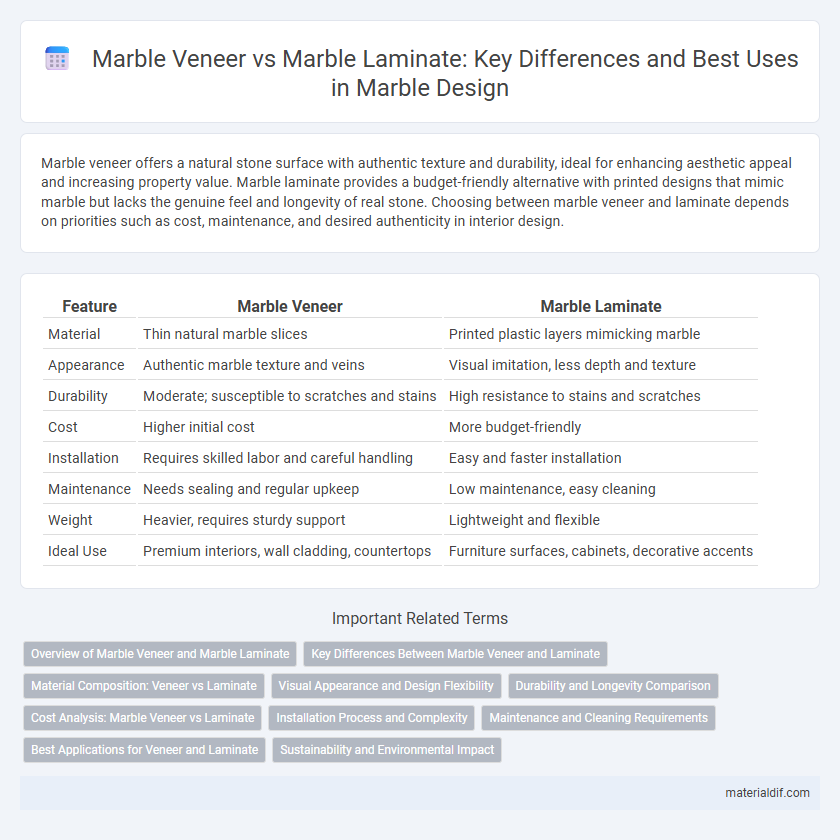Marble veneer offers a natural stone surface with authentic texture and durability, ideal for enhancing aesthetic appeal and increasing property value. Marble laminate provides a budget-friendly alternative with printed designs that mimic marble but lacks the genuine feel and longevity of real stone. Choosing between marble veneer and laminate depends on priorities such as cost, maintenance, and desired authenticity in interior design.
Table of Comparison
| Feature | Marble Veneer | Marble Laminate |
|---|---|---|
| Material | Thin natural marble slices | Printed plastic layers mimicking marble |
| Appearance | Authentic marble texture and veins | Visual imitation, less depth and texture |
| Durability | Moderate; susceptible to scratches and stains | High resistance to stains and scratches |
| Cost | Higher initial cost | More budget-friendly |
| Installation | Requires skilled labor and careful handling | Easy and faster installation |
| Maintenance | Needs sealing and regular upkeep | Low maintenance, easy cleaning |
| Weight | Heavier, requires sturdy support | Lightweight and flexible |
| Ideal Use | Premium interiors, wall cladding, countertops | Furniture surfaces, cabinets, decorative accents |
Overview of Marble Veneer and Marble Laminate
Marble veneer is a thin layer of natural marble cut from a larger slab, offering authentic texture, color variations, and durability for surfaces. Marble laminate consists of a printed design or synthetic material mimicking marble patterns, providing an affordable and low-maintenance alternative with less resistance to heat and scratches. Choosing between marble veneer and marble laminate depends on desired aesthetics, budget, and application durability.
Key Differences Between Marble Veneer and Laminate
Marble veneer is a thin slice of natural marble bonded to a substrate, offering authentic texture and unique veining, while marble laminate is a printed surface designed to mimic marble's appearance but lacks natural stone properties. Veneer provides greater durability, heat resistance, and the ability to be refinished, whereas laminate is more cost-effective yet prone to scratches and heat damage. The choice between marble veneer and laminate depends on budget constraints, aesthetic preferences, and intended application environments requiring varying levels of durability and maintenance.
Material Composition: Veneer vs Laminate
Marble veneer consists of thin slices of natural marble adhered to a substrate, ensuring authentic stone aesthetics and durability. Marble laminate features a photographic layer of marble patterns printed on composite materials, offering a budget-friendly and lightweight alternative. The key difference in material composition lies in veneer using genuine stone, while laminate relies on synthetic imitations for surface appearance.
Visual Appearance and Design Flexibility
Marble veneer offers a natural stone appearance with authentic veining and texture that enhances luxury and elegance in interior design. Marble laminate mimics the look of real marble but provides greater design flexibility with a wider variety of patterns and colors, allowing customization for different styles. While veneer maintains true stone aesthetics, laminate is more versatile for budget-conscious projects seeking diverse visual options.
Durability and Longevity Comparison
Marble veneer offers superior durability compared to marble laminate, as it consists of a thin layer of genuine marble bonded to a substrate, maintaining the natural stone's resistance to scratches and heat. Marble laminate, made from printed images of marble on particleboard or MDF, tends to wear down faster, showing signs of peeling, chipping, and fading over time. For long-term applications requiring resilience and authentic appearance, marble veneer provides a significantly longer lifespan.
Cost Analysis: Marble Veneer vs Laminate
Marble veneer offers a luxurious and authentic stone appearance typically costing between $50 and $100 per square foot, reflecting its natural material and labor-intensive installation. In contrast, marble laminate ranges from $10 to $30 per square foot, providing a budget-friendly alternative with printed synthetic layers that mimic marble patterns but lack durability. Maintenance and long-term value favor marble veneer due to its resistance to scratching and heat, while laminate may require more frequent replacement, affecting overall cost efficiency.
Installation Process and Complexity
Marble veneer installation requires precise cutting and skilled handling to ensure natural stone slabs fit seamlessly, often involving adhesive bonding to solid surfaces. Marble laminate is simpler to install, using pre-finished sheets applied with contact cement or adhesive on flat, prepared substrates, reducing labor and time significantly. The complexity of marble veneer installation demands professional expertise due to weight, fragility, and alignment issues, whereas marble laminate offers a more DIY-friendly approach with minimal specialized tools.
Maintenance and Cleaning Requirements
Marble veneer requires careful maintenance, including regular sealing to prevent staining and gentle cleaning with pH-neutral products to preserve its natural beauty. Marble laminate offers greater durability and easier cleaning, as its protective overlay resists stains and scratches without the need for sealing. Choosing marble veneer demands more attentive upkeep, whereas marble laminate suits low-maintenance environments with frequent use.
Best Applications for Veneer and Laminate
Marble veneer is best suited for high-end architectural elements, wall cladding, and custom furniture where authentic texture and natural stone appearance are essential. Marble laminate excels in cost-effective surface coverings, such as countertops, cabinetry, and commercial interiors, offering easy maintenance and durability. Choosing between veneer and laminate depends on factors like budget, aesthetic preference, and application environment.
Sustainability and Environmental Impact
Marble veneer offers higher sustainability by utilizing thin slices of natural marble, reducing raw material consumption and minimizing quarrying impact compared to marble laminate, which often incorporates synthetic adhesives and resins that may release volatile organic compounds (VOCs). The natural composition of marble veneer also allows for better recyclability and biodegradability, whereas marble laminate's composite structure poses challenges for end-of-life disposal and environmental degradation. Opting for marble veneer supports eco-friendly building practices by lowering carbon footprint and promoting responsible resource management within the stone industry.
Marble veneer vs marble laminate Infographic

 materialdif.com
materialdif.com